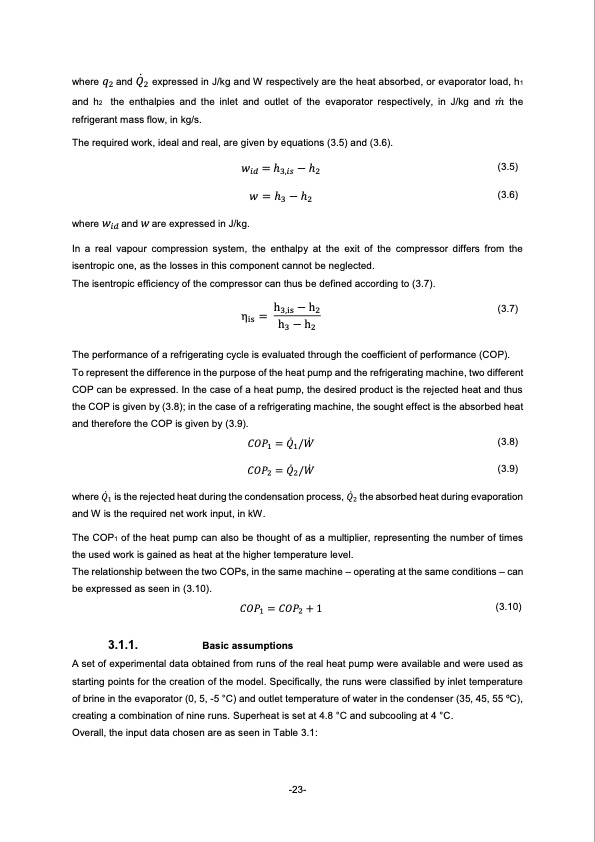
PDF Publication Title:
Text from PDF Page: 032
where 𝑞2 and 𝑄̇2 expressed in J/kg and W respectively are the heat absorbed, or evaporator load, h1 and h2 the enthalpies and the inlet and outlet of the evaporator respectively, in J/kg and 𝑚̇ the refrigerant mass flow, in kg/s. The required work, ideal and real, are given by equations (3.5) and (3.6). where 𝑤𝑖𝑑 and 𝑤 are expressed in J/kg. In a real vapour compression system, the enthalpy at the exit of the compressor differs from the isentropic one, as the losses in this component cannot be neglected. The isentropic efficiency of the compressor can thus be defined according to (3.7). The performance of a refrigerating cycle is evaluated through the coefficient of performance (COP). To represent the difference in the purpose of the heat pump and the refrigerating machine, two different COP can be expressed. In the case of a heat pump, the desired product is the rejected heat and thus the COP is given by (3.8); in the case of a refrigerating machine, the sought effect is the absorbed heat and therefore the COP is given by (3.9). where 𝑄̇1 is the rejected heat during the condensation process, 𝑄̇2 the absorbed heat during evaporation and W is the required net work input, in kW. The COP1 of the heat pump can also be thought of as a multiplier, representing the number of times the used work is gained as heat at the higher temperature level. The relationship between the two COPs, in the same machine – operating at the same conditions – can be expressed as seen in (3.10). 3.1.1. Basic assumptions A set of experimental data obtained from runs of the real heat pump were available and were used as starting points for the creation of the model. Specifically, the runs were classified by inlet temperature of brine in the evaporator (0, 5, -5 °C) and outlet temperature of water in the condenser (35, 45, 55 oC), creating a combination of nine runs. Superheat is set at 4.8 °C and subcooling at 4 °C. Overall, the input data chosen are as seen in Table 3.1: 𝑤𝑖𝑑 = h3,𝑖𝑠 − h2 𝑤 = h3 − h2 (3.5) (3.6) ηis = h3,is − h2 h3 − h2 (3.7) ̇̇ 𝐶𝑂𝑃 = 𝑄 /𝑊 11 ̇̇ 𝐶𝑂𝑃 = 𝑄 /𝑊 22 (3.8) (3.9) 𝐶𝑂𝑃 =𝐶𝑂𝑃 +1 12 (3.10) -23-PDF Image | Next generation of refrigerants for residential heat pump systems

PDF Search Title:
Next generation of refrigerants for residential heat pump systemsOriginal File Name Searched:
MartinaLonghini_ThesisReport.pdfDIY PDF Search: Google It | Yahoo | Bing
CO2 Organic Rankine Cycle Experimenter Platform The supercritical CO2 phase change system is both a heat pump and organic rankine cycle which can be used for those purposes and as a supercritical extractor for advanced subcritical and supercritical extraction technology. Uses include producing nanoparticles, precious metal CO2 extraction, lithium battery recycling, and other applications... More Info
Heat Pumps CO2 ORC Heat Pump System Platform More Info
| CONTACT TEL: 608-238-6001 Email: greg@infinityturbine.com | RSS | AMP |